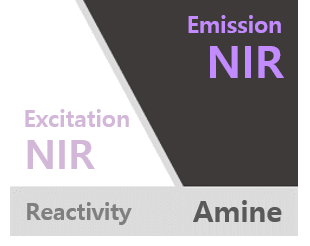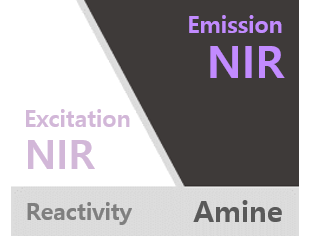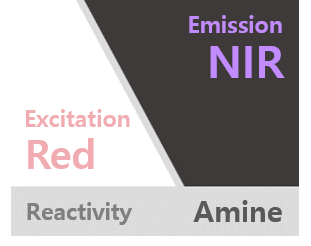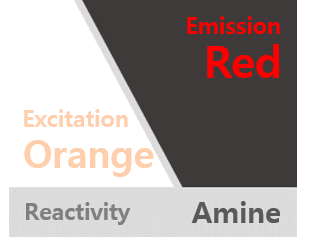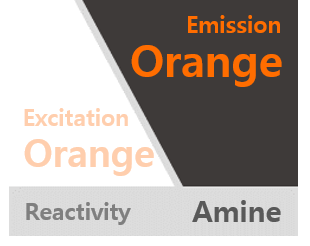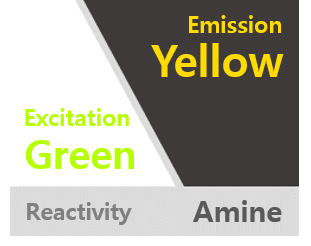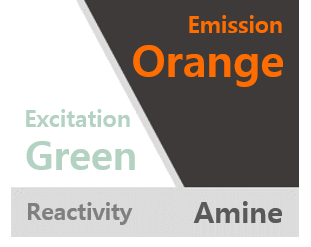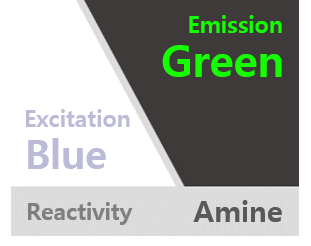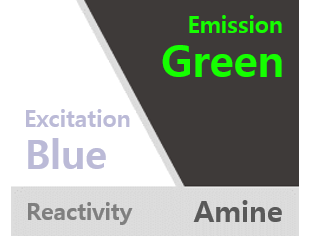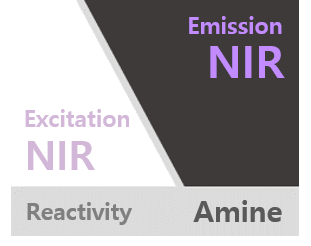
 >
Products
>
>
>
>
Products
>
>
>
- Flamma® Fluors NHS ester
- Flamma® Fluors Sulfo-NHS ester
- Flamma® Fluors Vinylsulfone
- Flamma® Fluors Isothiocyanate
- Flamma® Fluors Maleimide
- Flamma® Fluors Hydrazide
- Flamma® Fluors Dichlorotriazine
- Flamma® Fluors Carboxylic acid
- Flamma® Fluors Amine
- Flamma® Fluors Thiol
- Flamma® Fluors Alkyne
- Flamma® Fluors PEG4-Alkyne
- Flamma® Fluors ADIBO
- Flamma® Fluors Azide
Flamma® 648 Vinylsulfone
| PACKING UNIT | price |
Lead time |
|---|---|---|
| 1 mg | $113.00 | |
| 5 mg | $273.00 | |
| 25 mg | $541.00 |
Description
Flamma® Fluors 648 Vinylsulfone is pH insensitive reactive form of red dye that used to generate a stable fluorescence signal in bioimaging. Vinylsulfone reactive group, developed by BioActs’ leading technology, is stable in a wide range of pH and at the high temperature. The maxima of Ex/Em values are at 648/663 nm, similar to that of Alexa 647, Cy5, ATTO 647N and DyLight 650. Flamma 648 might be excited using 593 or 633 nm laser line and displays excellent optical property. Flamma 648 can be conjugated to low-abundance of biomolecules with great sensitivity and high d/P ratio, enabling sensitive detection. Vinylsulfones readily react with primary amines of amino-modified oligonucleotides or of proteins to form a stable amino linkage between dye and the biomolecule. We offer Flamma 648 Vinylsulfone for labeling of antibodies, peptides, proteins, ligands and amplification substrates optimized for cellular labeling and detection.
Citation & Reference
1. Fan W, A novel conductive microtubule hydrogel for electrical stimulation of chronic wounds based on Biological Electrical Wires. Journal of Nanobiotechnology. 2024 May 16;22(1).
2. Zhang M, Multifunctional Metal Complex-based gene delivery for tumour immune checkpoint blockade combination therapy. Journal of Drug Targeting. 2022 Apr 3;30(7):753–66.
3. Kinney SM, Degradable methacrylic acid-based synthetic hydrogel for Subcutaneous Islet Transplantation. Biomaterials. 2022 Feb;281:121342.
4. Jung SJ, In-vivo half-life and hypoglycemic bioactivity of a fusion protein of exenatide and elastin-based polypeptide from recombinant saccharomyces cerevisiae. Journal of Biotechnology. 2019 Sept;303:16–24.
5. Kawano, S., A landmark in drug discovery based on complex natural product synthesis. Sci Rep 9, 8656 (2019).
6. Thi Nguyen N-T, Mono-pegylates of exenatide in branched and dimeric structures can improve in vivo stability and hypoglycemic bioactivity. Journal of Biotechnology. 2019 Dec;306:89–96.
7. Yhee, Ji Young. Cancer-targeted MDR-1 siRNA delivery using self-cross-linked glycol chitosan nanoparticles to overcome drug resistance. Journal of Controlled Release 198 (2015): 1-9.
8. Lee, Eunjung. Co-delivery of chemosensitizing siRNA and an anticancer agent via multiple monocomplexation-induced hydrophobic association. Journal of Controlled Release 210 (2015): 105-114.
9. Park, Solji. Amphiphilized poly (ethyleneimine) nanoparticles: a versatile multi-cargo carrier with enhanced tumor-homing efficiency and biocompatibility. Journal of Materials Chemistry B 3.2 (2015): 198-206.
10. Hollis, Christin P. In vivo investigation of hybrid paclitaxel nanocrystals with dual fluorescent probes for cancer theranostics. Pharmaceutical research 31.6 (2014): 1450-1459.
11. Yoon, Hong Yeol. Glycol chitosan nanoparticles as specialized cancer therapeutic vehicles: Sequential delivery of doxorubicin and Bcl-2 siRNA. Scientific reports 4 (2014).
12. Oh, Keun Sang. Accurate sequential detection of primary tumor and metastatic lymphatics using a temperature-induced phase transition nanoparticulate system. International journal of nanomedicine 9 (2014): 2955.
13. Lee, So Jin. TNF-α gene silencing using polymerized siRNA/thiolated glycol chitosan nanoparticles for rheumatoid arthritis. Molecular Therapy 22.2 (2014): 397-408.
14. Park, Jin Woo. Wide-Ranged Fluorescent Molecular Weight Size Markers for Electrophoresis. Bulletin of the Korean Chemical Society 34.1 (2013): 29-30.
15. Yoon, Hong Yeol. Bioreducible hyaluronic acid conjugates as siRNA carrier for tumor targeting. Journal of Controlled Release 172.3 (2013): 653-661.
16. Yhee, Ji Young. Tumor-targeting transferrin nanoparticles for systemic polymerized siRNA delivery in tumor-bearing mice. Bioconjugate chemistry 24.11 (2013): 1850-1860.
17. Yoon, Hong Yeol. Photo-crosslinked hyaluronic acid nanoparticles with improved stability for in vivo tumor-targeted drug delivery. Biomaterials 34.21 (2013): 5273-5280.
18. Keunsoo Jeong. Poly (oxyethylene sugaramide) s: unprecedented multihydroxyl building blocks for tumor-homing nanoassembly. Journal of Materials Chemistry B 1.28 (2013): 3437-3442.
19. Lim, Chang-Keun. Gadolinium-coordinated elastic nanogels for in vivo tumor targeting and imaging. Biomaterials 34.28 (2013): 6846-6852.
20. Zhu, Lei. Real-time monitoring of caspase cascade activation in living cells. Journal of controlled release 163.1 (2012): 55-62.
21. Koo, Heebeom. The movement of self-assembled amphiphilic polymeric nanoparticles in the vitreous and retina after intravitreal injection. Biomaterials 33.12 (2012): 3485-3493.
22. Lim, Chang-Keun. Phthalocyanine-aggregated polymeric nanoparticles as tumor-homing near-infrared absorbers for photothermal therapy of cancer. Theranostics 2.9 (2012): 871-879.
23. Park, Jin Woo. Novel cyanine dyes with vinylsulfone group for labeling biomolecules. Bioconjugate chemistry 23.3 (2012): 350-362.
24. Ryu, Ju Hee. Early diagnosis of arthritis in mice with collagen?induced arthritis, using a fluorogenic matrix metalloproteinase 3–specific polymeric probe. Arthritis & Rheumatism 63.12 (2011): 3824-3832.
25. Ibrahim, Basma M. A strategy to deliver genes to cystic fibrosis lungs: a battle with environment. Journal of controlled release 155.2 (2011): 289-295.
26. Xu, Peisheng. Zwitterionic chitosan derivatives for pH-sensitive stealth coating. Biomacromolecules 11.9 (2010): 2352-2358.
OPTION
Total

 log
log My
My Contact
Contact
